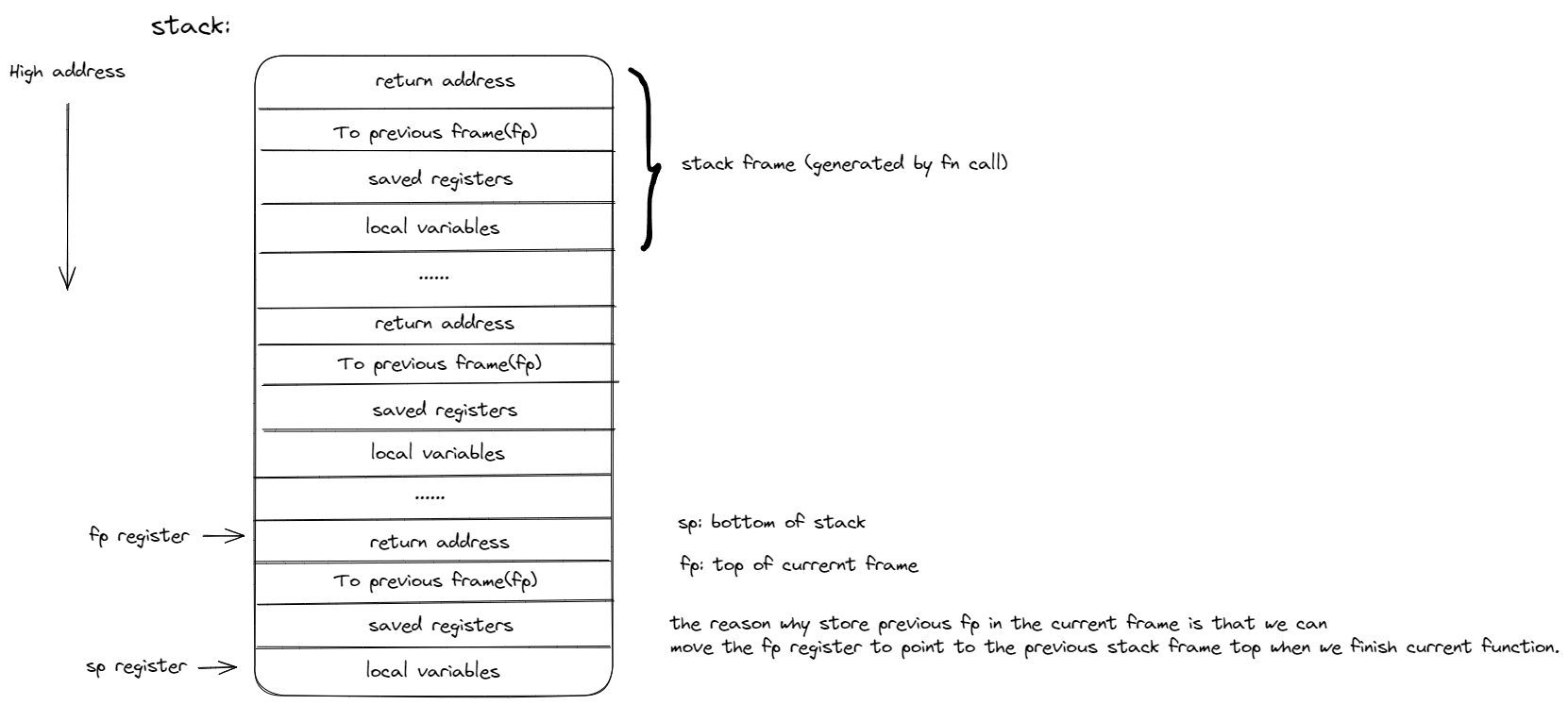Q1 RISC-V assembly
C 代码:
int g(int x) {
return x+3;
}
int f(int x) {
return g(x);
}
void main(void) {
printf("%d %d\n", f(8)+1, 13);
exit(0);
}
生成的汇编代码:
000000000000001c <main>:
void main(void) {
1c: 1141 addi sp,sp,-16 // 分配栈空间
1e: e406 sd ra,8(sp) // 保存main的返回地址,因为接下来要调用printf
20: e022 sd s0,0(sp) // 保存前一个函数的frame pointer
22: 0800 addi s0,sp,16 // 现在frame pointer要增加16Bytes
printf("%d %d\n", f(8)+1, 13);
24: 4635 li a2,13
26: 45b1 li a1,12
28: 00000517 auipc a0,0x0
2c: 7a050513 addi a0,a0,1952 # 7c8 <malloc+0xe8> // "%d %d\n"字符串地址
30: 00000097 auipc ra,0x0 // ra=pc=0x30
34: 5f8080e7 jalr 1528(ra) # 628 <printf> // 0x30 + 0x5f8 = 0x628
exit(0);
38: 4501 li a0,0 // exit的参数,传入0
3a: 00000097 auipc ra,0x0
3e: 274080e7 jalr 628(ra) # 2ae <exit>
1.Which registers contain arguments to functions? For example, which register holds 13 in main’s call to printf?
由生成的汇编可知,13 保存在寄存器a2中,f(8)+1 即 12 保存在寄存器a1中,字符串"%d %d\n"地址被保存到a0。
2.Where is the call to function f in the assembly code for main? Where is the call to g? (Hint: the compiler may inline functions.)
f(8)+1 在汇编中直接被展开成了 12。
3.At what address is the function printf located?
30: 00000097 auipc ra,0x0
34: 5f8080e7 jalr 1528(ra) # 628 <printf>
ra=0x30, 0x30+1528=0x628。
4.What value is in the register ra just after the jalr to printf in main?
执行 jalr 指令后,ra 寄存器被赋值为下一条指令,即 0x34+0x4=0x38 地址的指令:li a0,0。
5.Run the following code.
unsigned int i = 0x00646c72;
printf("H%x Wo%s", 57616, &i);
What is the output?
HE110, World.
第一个%x, 57616 对应十六进制 0xE110,第二个&i, 因为是小端序,解析出来的字符串排列顺序为0x72, 0x6c, 0x64, 0x00,查看 ascii 码表,对应字符串orld。
6.In the following code, what is going to be printed after ‘y=’? (note: the answer is not a specific value.) Why does this happen?
printf("x=%d y=%d", 3);
y 打印出来是个随机数。
Q2 Backtrace
栈分布参考如图:

根据CSAPP 3.7.1栈结构看,return address属于前一栈帧保存的,所以fp register应该指向return address的地址,即当前栈帧的顶部。一个栈帧中保存在最高位地址的是previous fp。所以这里最上面一个stack frame也应该把return address去掉。
读出当前的 frame pointer。xv6 给栈分配的空间是一个 page,当 fp 不指向该页的最高地址时,说明不是调用的第一个函数。
读出当前函数的返回地址,即上一层函数调用该函数的下一条指令,在 fp-8 的位置。因为我们要的是调用函数的地址,所以需要在返回地址再减去 8。
读出上一层函数的 fp 地址,在 fp-16 的位置。
void backtrace(void)
{
uint64 fp = r_fp();
uint64 ra;
printf("backtrace:\n");
while (fp < PGROUNDUP(fp))
{
ra = *(uint64 *)(fp - 8) - 8;
printf("%p\n", ra);
fp = *(uint64 *)(fp - 16);
}
}
make qemu 后执行 bttest, 得到函数调用过程:
$ bttest
backtrace:
0x0000000080002132
0x0000000080001fa4
0x0000000080001c8e
利用addr2line -e kernel/kernel